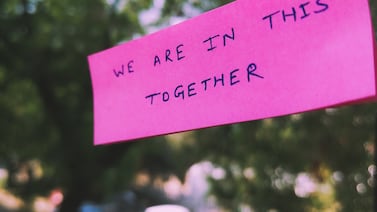In the hope of averting a strike, Chicago school officials will hit pause on a hotly debated reopening plan and take a 48-hour “cooling off period” in which no additional disciplinary action will be taken against teachers.
A joint statement from the mayor and schools chief Monday evening said that students will learn remotely Tuesday and Wednesday. Negotiations are expected to continue, a Chicago Public Schools official said.
The statement, released after a weekend that brought escalating tensions between the two sides, said that they had made additional progress on key issues Monday, but did not name the areas of agreement. “As a result of the progress we have made, and as a gesture of good faith, for now, teachers will retain access to their Google Suite,” the statement said.
It is unlikely that school buildings will reopen this week. The district has a pre-scheduled professional development day on Friday, making it a short week for schools.
Union officials have agreed to the 48-hour cooling off period, according to a union source, but have told their delegates to keep evenings free this week for a meeting of its representative body.
That meeting could be to start the steps toward a strike, or to move toward ratifying an agreement.
Monday’s developments are the latest in a closely watched series of negotiations that have increasingly attracted national attention in the ongoing debate about whether it’s safe to reopen schools.
Chicago initially reopened schools for prekindergarten and some special education students in January, but as tensions with its teachers union heated up, that attempt faltered. In protest of the plan, some teachers did not report to school buildings as directed, and the district locked out about 100 of them, curtailing access to email and key technology platforms.
After the school district said it wanted to move ahead with the next phase of its plan — which called for bringing some 70,000 students in kindergarten through eighth grade back to classrooms Monday — the union narrowly passed a resolution that called for all teachers and some paraprofessionals to work remotely until the union and the district reached an agreement on the reopening plan. If the district moved to lock out additional teachers, the union said it would strike.
The ongoing standoff has not only delayed the second stage of Chicago’s reopening plan, but it could disrupt remote learning for the district’s 300,000 students should a strike unfold.
The two sides have reached tentative agreements on four key issues: contact tracing; ventilation; health and safety protocols, such as personal protective equipment and cleaning and disinfection protocols; and school-level safety committees that will provide some oversight on safety and mitigation.
But sticking points remain. Among them: the timeline under which teachers would receive vaccines, what test positivity rate threshold the district would use to determine when to revert to fully in-person learning, and how teachers with high-risk family members are prioritized for remote work accommodations.
In a tearful call with community group leaders on Monday, the mayor complained that the union had brought forth additional items on which she was not willing to negotiate because they are outside the scope of reopening. She said those included reduced instruction time, defunding the school police program, and an affordable housing plan. (The Chicago Teachers Union sees itself as operating in the model of “common good” bargaining, which includes pushing for social demands beyond those immediately related to salary and working conditions.)
Meanwhile, over the weekend, Chicago Public Schools did reach agreement on in-person work with another key group: the union that represents special education aides, bus drivers and school security workers.
Under the agreement with Service Employees International Union Local 73, announced Sunday, special education aides are allowed to work remotely to serve students who have not opted for in-person learning, and the district promised to prioritize reviewing remote work accommodations for school-based staff with family at risk of severe illness from COVID-19.
In case of a strike, the agreement said, special education aides, bus aides and bus monitors would be allowed to work remotely without loss of pay.
As talks are set to continue, families remain in the dark about when schools could reopen for in-person learning.
Parent petitions circulated Monday morning urging the district not to cut off digital access for teachers. One of them, started by parents opposed to the district’s reopening plan, had amassed more than 1,800 signatures by mid-morning.
Some families also took part in a Monday “sick-out” to, as one parent put it, “demonstrate that parents are important stakeholders and deserve a voice in this conversation.” Throughout the reopening debate, parents and students frequently have said they felt left out of the conversation and that neither the school district nor the union took into consideration their needs.
“We are trying to take it one day at a time,” said one parent, Angela Foster-Rice, last week. Her fifth-grade daughter will keep learning from home. “It’s very strange and really unsettling right now.”








